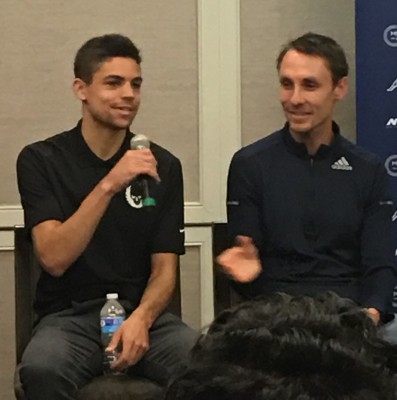Good News: Nick Willis Thinks Most Elite Runners Are Above Board; Bad News: He Thinks A High Percentage Of The Top Performers Are Dirty
by Robert Johnson
February 18, 2016
NEW YORK — Today at the 2016 NYRR Millrose Games press event, New Zealand miler Nick Willis had some interesting things to say about track and field’s doping problem. Recently, Athletics Kenya was put on probation by the World Anti-Doping Agency for not meeting a WADA deadline to prove it was doing enough to fight doping; Athletics Kenya may not have the funds or expertise to properly set up an independent testing agency. Instead of banning federations that run afoul of the WADA Code — the IAAF suspended Russia after December’s WADA Independent Commission report and may do the same to Kenya — Willis had a different solution.
Here is Willis’ recommendation:
“One unique outlook I’ve sort of thought may be a possible solution is rather than [banning] federations, why not create a situation where the top 10 or top 15 athletes in the world, they have to train at least 10 months of the year in a country where the country is under the compliant WADA Code. If they are from a country that doesn’t have those places — a lot of my competitors are from Kenya, Ethiopia, or Djibouti, a lot of places that don’t have the funds to [have compliant testing facilities]. If you are a top-10 or top-15 athlete in the world, you have the sponsors, you have the means to go and train in Flagstaff as opposed to altitude there. It’s not ideal and it’s not necessarily fair, but it’s also not fair that a lot of these athletes are getting away with training in places where the testers cannot access them.”
After the main press event, Willis continued to talk about doping with Chris Lotsbom and myself. You can listen to much of that exchange below (some additional footage from before I stared film in is on RunnerSpace here but that doesn’t include the key part of my video, which begins at 2:55) but I’ll give you the highlights.
When I asked Willis if the doping problem was better now than when he started as a professional, Willis was emphatic that things are much better now.
“Absolutely,” said Willis. “In 2004, when I first made the Olympics, [people would ask me], ‘How many of the medallists were doping?’ [and] I’d say, ‘How many of the finalists are doping?’ and I’d say it was much higher than 50% of the finalists. Whereas now, it’s only really the top three or four guys [where] there’s is a high percentage that are doing it.
“But, just like with the [Rashid] Ramzi situation in 2008, it becomes more evident (that they are doping now) because they are so much further ahead – the one or two or three that are doing it. Whereas in the late 90s, early 2000s, I think there was such a high percentage doing it that it wasn’t obvious as they all were ahead at the same time.”
Since Willis had just said “it’s only really the top three or four guys [where] there’s is a high percentage that are doing it,” I wanted clarification. I asked him, “So you think there is a high percentage of the medalists in the 1,500 right now that are dirty?”
Willis responded, “I don’t know specific people. Again, I’m at risk of libel if I ever say anything about specific people.”
I then asked if he was talking about a high percentage of ,1500 medalists or all distance medalists and Willis focused on the positive and how much better anti-doping is now than when he began his pro career.
“I think as a whole, the testing has gotten a whole lot better. I think the blood passport has gotten better. Now they are catching people for CERA and EPO, people are veering away from that sort of stuff. I just think as a whole the only people who can sort of get away with doping now [are those with] very, very sophisticated methods to beat the testing system or they have to be in a very, very sort of closed-off environment either from testing or from just word-of-mouth being able to spread what is going on. And those are select groups that can take place now. By and large, I think most people are above board.”
In terms of track talk, Willis interesting said that he views himself and Centrowitz to be very similar in one key way besides the fact that both are incredibly smooth. “I think we are secretly 5k runners with a little bit of speed who use that to run miles,” said Willis.
In terms of his most vivid Millrose moment, Willis, who has twice finished second and twice finished third in the Wanamaker Mile, said it was the 2009 Wanamaker Mile at Madison Square Garden when he was intent on beating the “Chairman of the Boards” Bernard Lagat just months after Willis had won his Olympic 1,500 medal. Willis said he attacked just as planned on the penultimate lap and was thrilled to get the lead he coveted at was very hard to run from behind on the tight MSG track. Willis was proud of himself for getting the lead but before he knew it, Lagat was the champion. “He absolutely blew the doors off me. I still have nightmares about him making me look like an absolute turd out there,” said Willis.
(Interview is cued to the start at the most interesting part)
Talk about this article on our message board: Nick Willis had some fascinating things to say about doping today. Plenty of good and bad news!




